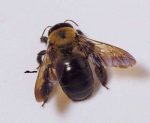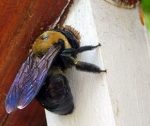Safely Exterminating Carpenter Bees
What are Carpenter Bees?
Carpenter bees are large, black and yellow bees frequently seen in spring hovering around the eaves of a house or the underside of a deck or porch rail. They are most often mistaken for bumble bees, but differ in that they have a black shiny tail section. The carpenter bee is so called because of its habit of excavating tunnels in wood with its strong jaws. The round, half-inch diameter entrance holes are usually found on the underside of a board. A tell-tale trace of coarse sawdust is often found on the surface beneath the hole. Wooden decks, overhangs, and other exposed wood on houses are prime targets. Painted and treated woods are less preferred, but they are by no means immune to attack.
While the damage to wood from the drilling activities of a single bee is slight, subsequent years’ broods will expand the tunnel through branching activities and may cause considerable structural damage. Additionally, they will commonly defecate on the wall or other item directly below the opening causing stains.
Identifying Carpenter Bees
The male carpenter bee that is most often noticed, but is unable to sting. They hover in the vicinity of the nest and will dart after any other flying insect that ventures into their territory. A common behavior of the males is to approach people if they move quickly or wave a hand in the air. The males may even hover a short distance from people, causing unnecessary panic. The female, however, is capable of stinging but seldom does. She must be extremely provoked (i.e. handled) before she will sting.
Carpenter bees do not eat wood. They excavate the tunnels for shelter and as chambers in which to rear their young. They usually attack unpainted objects such as doors, windowsills, roof eaves, shingles, railings, telephone poles, and sometimes wooden lawn furniture.
A carpenter bee begins her nest by drilling a nearly perfectly round entrance hole (about 1/2 inch diameter) into the wood. This hole is usually against the grain of the wood. When the tunnel is about 1 inch deep, the bee turns at right angles to the initial hole and tunnels with the grain of the wood. Bees prefer to attack wood that is greater than two inches thick.




